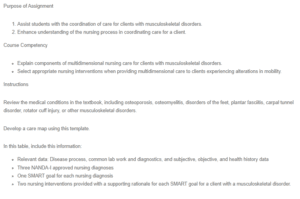Designing a Care Map – Osteoporosis, Distal Radius Fracture
| Relevant Data | Three NANDA-I Approved Nursing Diagnosis | One Smart Goal for EACH Nursing Diagnosis | Two Nursing Interventions with Rationale for EACH SMART Goal |
| Disease Process: Osteoporosis, distal radius fracture.
Common Labwork/Diagnostics: Complete Blood Count (CBC) Comprehensive Metabolic Panel (CMP): Vitamin D Levels: Thyroid Function Tests Bone Turnover Markers: Dual-Energy X-ray Absorptiometry (DXA) Scan: X-rays Bone Scintigraphy Magnetic Resonance Imaging (MRI) Assessment Data (consider subjective, objective, and heath history): Subjective Data Wrist pain (7/10) low appetite Difficulty with meal preparation. Objective Data Low body weight (85 pounds) Medical history Health History Type 1 diabetes Bipolar disorder Depression Hysterectomy Smoking
|
Nursing Diagnosis:
Risk for falls related to osteoporosis, impaired balance, and history of fractures.
Nursing Diagnosis: Ineffective self-health management related to poor nutrition and meal skipping.
Nursing Diagnosis Risk for impaired skin integrity related to osteoporosis, low body weight, and limited mobility. |
SMART Goal:
The patient’s balance and fall risk will be positively impacted through regular physical therapy exercises, as indicated by a 20% decrease in fall risk within six weeks.
SMART Goal: The patient’s nutritional status will be enhanced through strict adherence to a diabetic diet and consistent administration of prescribed insulin, aiming to attain and sustain a healthy weight within three months.
SMART Goal: The patient will demonstrate a high level of cognitive ability, as evidenced by the absence of pressure ulcers, within four weeks. |
1. Offer guidance on home safety measures, such as eliminating potential tripping hazards and utilizing handrails.
Reasoning: Mitigating environmental hazards is crucial for preventing falls (Campani et al., 2020).
2. Work with a physical therapist to create a customized exercise program that emphasizes improving balance and building strength. Reasoning: Regular physical activity enhances balance and decreases the likelihood of falling in individuals with osteoporosis.
1. Work with a registered dietitian to develop a customized meal plan, focusing on foods rich in nutrients and maintaining consistent meal schedules. Reasoning: Proper nutrition plays a vital role in effectively managing diabetes and attaining a balanced weight (Gray & Threlkeld, 2019). 2. Offer knowledge regarding the significance of insulin management, highlighting the necessity of regular insulin pump usage and monitoring blood glucose levels. Reasoning: Maintaining a regular insulin regimen is essential for managing blood sugar levels and promoting overall well-being in individuals with diabetes.
1. Perform routine skin evaluations. Reasoning: Conducting regular skin assessments can aid in the early detection of skin breakdown, enabling prompt intervention and the prevention of pressure ulcers (National Library of Medicine, 2018). 2. Offer guidance on skin protection and repositioning techniques: Reasoning: By providing education on effective skin care and repositioning techniques, the patient can be empowered to actively prevent pressure ulcers, considering their limited mobility and risk factors. |
References
Campani, D., Caristia, S., Amariglio, A., Piscone, S., Ferrara, L. I., Barisone, M., Bortoluzzi, S., Faggiano, F., Dal Molin, A., Silvia Zanetti, E., Caldara, C., Bellora, A., Grantini, L., Lombardi, A., Carimali, C., Miotto, M., Pregnolato, A., & Obbia, P. (2020). Home and environmental hazards modification for fall prevention among the elderly. Public Health Nursing, 38(3), 493–501. https://doi.org/10.1111/phn.12852
Gray, A., & Threlkeld, R. J. (2019). Nutritional recommendations for individuals with diabetes. Nih.gov; MDText.com, Inc. https://www.ncbi.nlm.nih.gov/books/NBK279012/
National Library of Medicine. (2018, November 15). Preventing pressure ulcers. Nih.gov; Institute for Quality and Efficiency in Health Care (IQWiG). https://www.ncbi.nlm.nih.gov/books/NBK326430/
ORDER A PLAGIARISM-FREE PAPER HERE
We’ll write everything from scratch
Question

Osteoporosis, Distal Radius Fracture
Purpose of Assignment
- Assist students with the coordination of care for clients with musculoskeletal disorders.
- Enhance understanding of the nursing process in coordinating care for a client.
Course Competency
- Explain components of multidimensional nursing care for clients with musculoskeletal disorders.
- Select appropriate nursing interventions when providing multidimensional care to clients experiencing alterations in mobility.
Instructions
Review the medical conditions in the textbook, including osteoporosis, osteomyelitis, disorders of the feet, plantar fasciitis, carpal tunnel disorder, rotator cuff injury, or other musculoskeletal disorders.
Develop a care map using this template.
In this table, include this information:
- Relevant data: Disease process, common lab work and diagnostics, and subjective, objective, and health history data
- Three NANDA-I approved nursing diagnoses
- One SMART goal for each nursing diagnosis
- Two nursing interventions provided with a supporting rationale for each SMART goal for a client with a musculoskeletal disorder.

